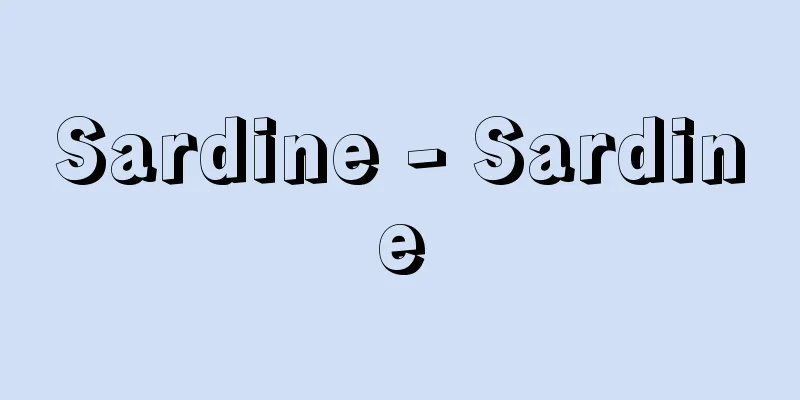Chichibu geosyncline (English spelling)

|
A long and narrow sedimentary basin roughly the size of the Japanese archipelago that existed from the Silurian Period of the Paleozoic Era to the end of the Jurassic Period of the Mesozoic Era (approximately 440 million to 143 million years ago). It is a depositional area thought to be based on the theory of geosynclinal and orogenic movement. The Japanese archipelago was once on the edge of the Chinese mainland, but it is believed that it separated from the mainland and moved southeastward during the Neogene Period of the Cenozoic Era, forming the Sea of Japan. The Chichibu Geosyncline was formed on the edge of the Chinese mainland at that time. In other words, from the Carboniferous to the Permian Periods of the Paleozoic Era, basaltic magma rose in various places and formed undersea volcanoes. Coral reef limestone and fusulinite limestone were formed on the volcanic bodies. Radiolarian chert, fine-grained mudstone (claystone), volcanic clastic rocks carried from volcanic bodies, and tuff were deposited on the seabed, where terrestrial coarse-grained clastics could not reach easily. Meanwhile, sandstone, mudstone, and sandstone-mudstone interlayers were deposited on the seabed, where terrestrial coarse-grained clastics could easily reach. In the Triassic Period of the Mesozoic Era, volcanic activity became rare, and radiolarian chert was deposited. In the Jurassic Period, mudstone, sandstone-mudstone interlayers were deposited. In the Late Jurassic, land uplift occurred in various parts of the geosyncline, causing submarine landslides in the surrounding area. During the submarine landslides, the strata folded and broke apart, mixing together to form a disorganized deposit (olistostrome). The deposits of the Chichibu Geosyncline are unconformably covered by strata from the Early Cretaceous Period of the Mesozoic era, so it is thought that by the Early Cretaceous Period, most of the Chichibu Geosyncline had become land and formed a mountain range (the proto-Japanese backbone). Gneiss rocks and Precambrian granites distributed from the Hida region to the Noto Peninsula are presumed to be remnants of land on the continental side of the Chichibu Geosyncline. On the other hand, in the Kurosegawa-Ofunato area, a narrow, elongated zone about 10 km wide stretching from Ofunato in the Kitakami Mountains through Kurosegawa in Seiyo City, Ehime Prefecture, to Gokase in the Kyushu Mountains, granites from the early Paleozoic to the Precambrian are scattered throughout the area. This area was a shallow sea or land throughout the Paleozoic and Mesozoic eras, and shows a topography similar to that of the Ryukyu Islands today (known as the Kurosegawa-Ofunato Islands). It is presumed that this area once separated from the Chinese mainland and formed land or an elevation on the ocean side of the Chichibu Geosyncline. The strata of the Chichibu Geosyncline were subjected to the Akiyoshi Orogeny from the end of the Paleozoic to the Triassic period, and the Sagawa Orogeny in the Cretaceous period, and were folded and metamorphosed, subjected to intrusion by granite, and also subjected to fault movements such as those seen in the Median Tectonic Line. The fossil fauna found in the Paleozoic strata of the Chichibu Geosyncline indicates a subtropical to tropical climate. Furthermore, paleomagnetic studies of the Sino-Korean Plateau, which stretches from northern China to the Korean Peninsula, suggest that this land mass moved northward due to plate movement from a latitude near the equator to roughly its present latitude between the Late Jurassic and the Early Cretaceous. Taking all of this into consideration, it is estimated that the Chichibu Geosyncline was formed in an area much lower latitude than present. The deposits of the Chichibu Geosyncline are now considered to be accretionary deposits, where strata deposited on the ocean floor and in ocean trenches were attached to the lower bottom of the continental slope. The chert was deposited on the ocean floor, and the basaltic volcanic rocks and the limestone on top of it are from seamounts. The deposits that were previously called the Chichibu Geosyncline were mixed with terrigenous clastics in the ocean trenches. With the emergence of this idea, the term Chichibu Geosyncline is no longer used. [Yoshida Shizuo and Murata Akihiro] [References] | | | | | | | |Cenozoic | | Period| | | | | | | | |Source: Shogakukan Encyclopedia Nipponica About Encyclopedia Nipponica Information | Legend |
|
古生代シルル紀から中生代ジュラ紀末期(約4億4000万年~1億4300万年前)にかけて存在した、ほぼ日本列島の大きさの細長い堆積(たいせき)盆地。地向斜・造山運動論に基づいて考えられた堆積の場のこと。 日本列島はかつて中国大陸の縁にあったが、新生代新第三紀になって大陸から分離して南東方へ移動し、日本海が形成されたと推定されているので、秩父地向斜は当時の中国大陸縁に形成されたものである。すなわち、古生代石炭紀からペルム紀にかけて玄武岩質マグマが各所で上昇し、海底火山を形成した。火山体の上にはサンゴ礁石灰岩や紡錘虫石灰岩などが生じた。陸源の粗粒砕屑(さいせつ)物が到達しにくい海底には、放散虫チャート、細粒の泥岩(粘土岩)、火山体から運ばれる火山砕屑岩、凝灰岩などが堆積した。一方、陸源粗粒砕屑物の到達しやすい海底には、砂岩、泥岩、砂岩泥岩互層などが堆積した。中生代三畳紀に入ると火山活動はまれになり、放散虫チャートが堆積した。ジュラ紀に入ると泥岩、砂岩、砂岩泥岩互層などが堆積した。ジュラ紀後期には、地向斜内の各所で陸地の上昇がおこり、そこから周囲に海底地すべりがおこった。海底地すべりに際し、地層は褶曲(しゅうきょく)したり、ばらばらになって混合したりして、乱雑な堆積物(オリストストローム)を形成した。秩父地向斜の堆積物は中生代白亜紀初期の地層に不整合で覆われているので、秩父地向斜は白亜紀最初期までにはその大部分が陸化して山脈(原日本脊梁(せきりょう))を形成したと考えられる。 飛騨(ひだ)地方から能登(のと)半島に分布している片麻(へんま)岩類や先カンブリア時代の花崗(かこう)岩類などは、秩父地向斜の大陸側の陸地の名残(なごり)と推定される。一方、北上(きたかみ)山地の大船渡(おおふなと)から愛媛県西予(せいよ)市の黒瀬川を経て九州山地の五ヶ瀬(ごかせ)付近を連ねた幅10キロメートル前後の狭長な地帯、すなわち黒瀬川‐大船渡地帯には、古生代初期から先カンブリア時代の花崗岩類が点在している。この地帯は古生代、中生代を通じて浅海ないしは陸地であって、現在でいうと琉球(りゅうきゅう)列島のような地形をなしていたことを示している(黒瀬川‐大船渡列島とよばれている)。この地帯がかつて中国大陸から分離して秩父地向斜の大洋側の陸地ないしは高まりをなしたものと推定される。 秩父地向斜の地層は古生代末から三畳紀にかけての秋吉造山運動、白亜紀の佐川(さかわ)造山運動を被り褶曲、変成し、花崗岩の貫入を受け、さらに中央構造線などにみられる断層運動を被った。 秩父地向斜の古生層中に産する化石動物群は亜熱帯―熱帯の気候を示す。また中国の華北から朝鮮半島にかけての中朝卓状地における古地磁気の研究によれば、この地塊はジュラ紀後期から白亜紀最初期の間に、赤道付近の緯度からほぼ現在の緯度にプレート運動によって北上したものと推定されている。これらを考え合わせると、秩父地向斜は現在よりもかなり低緯度の地域で形成されたものと推定される。 秩父地向斜の堆積物は、現在では大洋底や海溝に堆積した地層が大陸斜面下底にはりついた付加堆積物と考えられている。チャートは大洋底に堆積したもの、玄武岩質火山岩類とその上にのる石灰岩は海山のもので、それらが海溝で陸源砕屑物と混ざり合ったものが、従来、秩父地向斜とよばれてきた堆積物の実体である。この考えが登場したことによって、秩父地向斜という用語は現在では使われなくなった。 [吉田鎮男・村田明広] [参照項目] | | | | | | | | | | | | | | | | | | |出典 小学館 日本大百科全書(ニッポニカ)日本大百科全書(ニッポニカ)について 情報 | 凡例 |
Recommend
Jersey City
A city in northeastern New Jersey, USA. Population...
Seigaiha
[1][一] The name of a Gagaku piece. Togaku. Shingak...
Nose print - Bimon
A pattern created by shallow grooves on the skin ...
Electromagnetic deflection
The bending of the direction of electron motion by...
Catalogue - Catalogue (in English) catalog/catalogue
Catalog. A catalog or guidebook for exhibits, prod...
Appeal Play - Apiru Play
...The catcher wears a mask, protector, and leg g...
Family name system
It is also called the "Ujikabane" syste...
Tikhonov, Nikolai Semënovich
Born: December 4, 1896 in St. Petersburg [Died] Fe...
Pandya Dynasty - Pāndya
A dynasty in South India. It ruled the southern t...
El Escorial Monastery - El Escorial Monastery
…It started with a style that combined Gothic str...
Decomposition voltage - Decomposition voltage
When an electrolyte solution or molten salt is el...
long-horned beetle
...The kanji for the beetle is "Tengyu"...
Bingling Temple Grottoes - Bingling Temple Grottoes
This cave temple is located in the Xiaojishi Moun...
Cullie - Cullie
...In many cases, they were built as imarets (or ...
Turkish-Greek War - Turkish-Greek War
After gaining independence from the Ottoman Empire...









